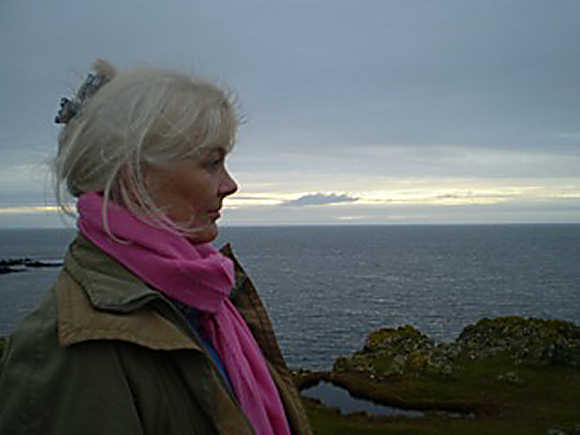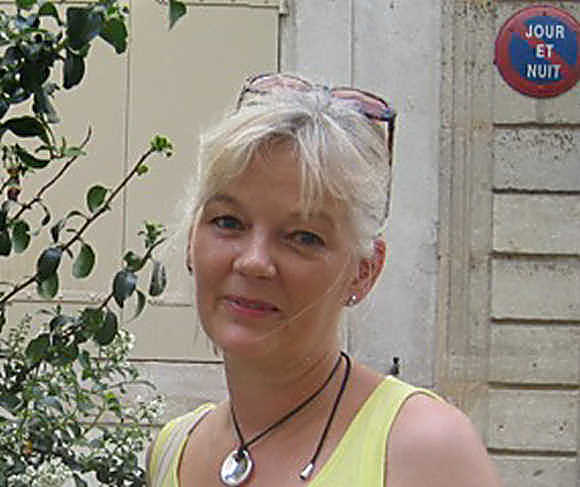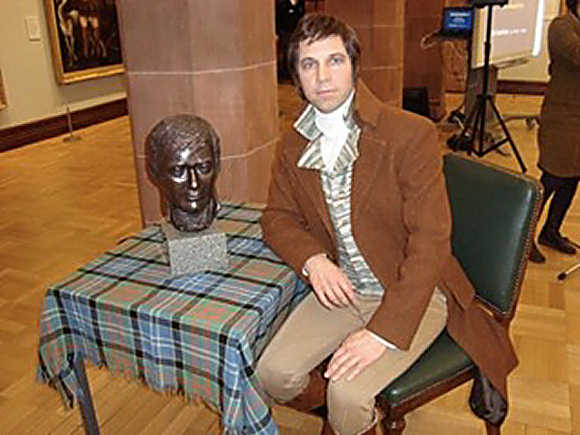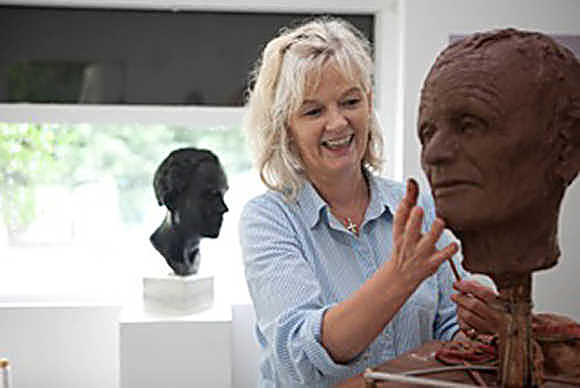|
Edited
by Frank R. Shaw, FSA Scot, Dawsonville, GA, USA
Email:
jurascot@earthlink.net
One of my
great joys in life is to attend various conferences or symposiums regarding
Robert Burns. It doesn’t hurt if the meeting is in Scotland. So just a few
weeks ago, Susan and I found ourselves one late January afternoon on a Delta
flight bound for Glasgow, via Dublin, to attend the annual Burns conference
at the University of Glasgow’s Centre for Robert Burns Studies. The
symposium was aptly called Robert Burns: Artefact.
I’ve met
some very interesting people at these meetings and this event was no
different. Usually those I meet are speakers, simply Burns lovers like me.
This time I had the privilege of meeting a lovely lady whose work as a
sculptor and artist is outstanding. I am indebted to imminent Burns scholar
Dr. David Purdie for introducing us. On display at the conference was a
portrait head of Robert Burns by Deirdre Nicholls, and she agreed to write
the following pages explaining how this particular work came about.

Deirdre Nicholls - a
sea shot taken by Professor David Purdie at Machrihanish
I love the
many statues of Burns around the world and have travelled near and far to
see as many of them as possible. In my home study is a bronze bust modelled
after one that resides in the cottage of the Burns Club of Atlanta. Using
that same mould, I commissioned a sculptor in Texas by the name of Whisper
to make my piece after he had completed one for The Heather and Thistle
Society in Houston which now graces the city’s International Sculpture
Garden in Hermann Park. I gave Whisper the freedom to make the bronze as if
it were his own. He did! It is simply a thing of beauty.
In 2009, I
inquired about a 250th official commemorative bust of the Bard celebrating
his birth in Alloway in 1759 which was being offered by Stone Icons Ltd in
London. The marble sculpture was designed and hand carved by noted sculptor
David Cornell and was the first to be carved since 1880. Fortunately one
was still available, and I was able to add it to our Burns memorabilia
collection as well.
While in
Scotland in July of that same year, Susan and I stopped off to visit
Ellisland with grandchildren Ian and Stirling and their parents, son Scott
and his wife Denise. We were thrilled to come away with a stunning Burns
maquette that had been gifted to Ellisland years before by Les Byers, the
farm’s caretaker. The group that oversees the property, Friends of Ellisland,
was in need of money for their ploughing contest, and I was happy to be of
help to them!
Currently
sitting on the window ledge behind my credenza is a small bronze statue of
Burns, a little less than two feet tall, staring across my desk at another
one of Sir Walter Scott who is returning the favor. Other smaller statuaries
I treasure are scattered about our office, including ones of Ernest
Hemingway and Winston Churchill.
I say all
this to let you know how much I prize the work of artists and sculptors.
While you and I see simply a piece of stone, the sculptor sees a statue.
Or, if we see a pot of hot metal, sculptors see a bronze work of art or, as
in this case, a portrait head. I may not know a lot about art, but I do know
what I like and I enjoy knowing that the statuaries and art we have are
keeping watch over our place of work. William Penn Warren once referred to
such as A Place to Come To, better still a place called home, a place of
comfort, of solitude, of joy, and at times, yes, even a place of refuge and
warmth. That is why certain “creature comforts” are so important to us.
In
designing her portrait head of Burns, Deirdre Nicholls relied on information
from various sources to gain a true perspective of the head size of Burns.
She then turned to three images of Burns most of us are familiar with - the
1787 Miers silhouette, the 1795-96 portrait by Alexander Reid, and the 1787
Nasmyth portrait. As a result, the finished product is a rare piece of art
that anyone, myself included, would love to have in their libraries or
homes!
It is with
pleasure I welcome talented sculptor Deirdre Nicholls to the pages of Robert
Burns Lives! She has produced a new work on Burns using her own technique to
design this modern piece of magnificent art. (FRS: 2.8.12)
DEIRDRE
NICHOLLS
BA (HON) ATC MBA FRSA

in Paris

Robert Burns
Bronze 2012

Actor Chris Tait, dressed as the Bard, posing
with Deirdre's portrait head of Burns at the recently refurbished National
Portrait Gallery in Edinburgh
This work
came about as a result of a suggestion from Professor David Purdie, a
renowned Burns expert, and a passionate devotee of his work. Professor
Purdie suggested that I produce a portrait head of Burns, and sponsored an
Artist’s Proof for his study, to provide inspiration for his work.
Work began
in summer 2011 on the portrait. Using information gleaned from descriptions
regarding his height and appearance, it was possible to estimate the size of
Burns’ skull.
After
roughing this out in clay to the correct size and proportions, close
examination was made of three images, which were produced during Burns’
lifetime.
These
were:
1.
The silhouette by J. Miers, from 1787
2. The portrait in profile by Alexander Reid from 1795-6
3. The ¾ portrait by Alexander Nasmyth painted in 1787
Other
existing images appear to be derivative, some drawings are mirror images
taken from the above sources, and were therefore not used. A painting by
Peter Tailor was not used as it is not a good painting, being more focussed
on a large hat than the face of the poet, and shows nothing useful for a
sculptor.
Larger
statues of Burns exist, some of which are exquisite, but the emphasis here
is on the pose and the clothing rather than on a true likeness. What the
sculptor is aiming at here is an impression of the subject. Clothing, pose
and hairstyle on statues give the viewer most of the visual information they
need to work out who the subject is. The faces on these statues are
therefore not very detailed, being smooth and unlined; the hair is often
wig-like in its structure. I therefore decided to use only the information
available from the contemporary images and descriptions.
Using
measurements from previous work on subjects of a similar height, I was able
to work out the shapes and proportions of Burns’ head.
When
beginning work on a portrait head, the profile is always my starting point,
so the Miers and Reid works were very useful.
The
biggest drawback in working from paintings is that they were designed to
flatter, and there are very few lines visible; lines not only give
character, they indicate the contours of the underlying structure.

in her studio with another of her pieces in
background
WORKING ON
THE HEAD
Work on
the clay took just over 2 months.
This clay
was delivered to the foundry, and the long process of converting this into
bronze began.
First of
all the clay was coated in a couple of layers of silicone rubber to
stabilise it and to take really fine details.
A plaster
cast was made, then a wax was cast from the plaster. The wax was then
worked on by hand to refine any details and make minor alterations. This was
then coated in several layers of china clay to retain as much detail as
possible, before being invested and finally burnt out. The bronze was then
melted in a crucible, and poured into the mould.

Pouring the bronze into the mould
When cool,
the sculpture was cleaned up, the excess bronze removed and final small
repairs and alterations completed before it was cleaned up and patinated.
A piece of
heavy stone was selected at an early stage; the weight of which is ideal to
support the bronze.
The stone
was prepared to take the bronze, and fittings were welded in place inside
the sculpture so that the head could be securely mounted.
EDITIONS
The
plaster mould will be able to withstand up to a maximum of 9 copies, plus
the 2 Artist’s proofs which have already been cast. Each piece in the
edition will be signed, dated and numbered to indicate where it is in the
order of casting. The first copy will therefore be marked 1/9. For further
information, please email:
deirdrenicholls@me.com
Or you may
contact her at The Edinburgh Sculpture Workshop,
25 Hawthornvale, Edinburgh EH6 4JT, Scotland |
